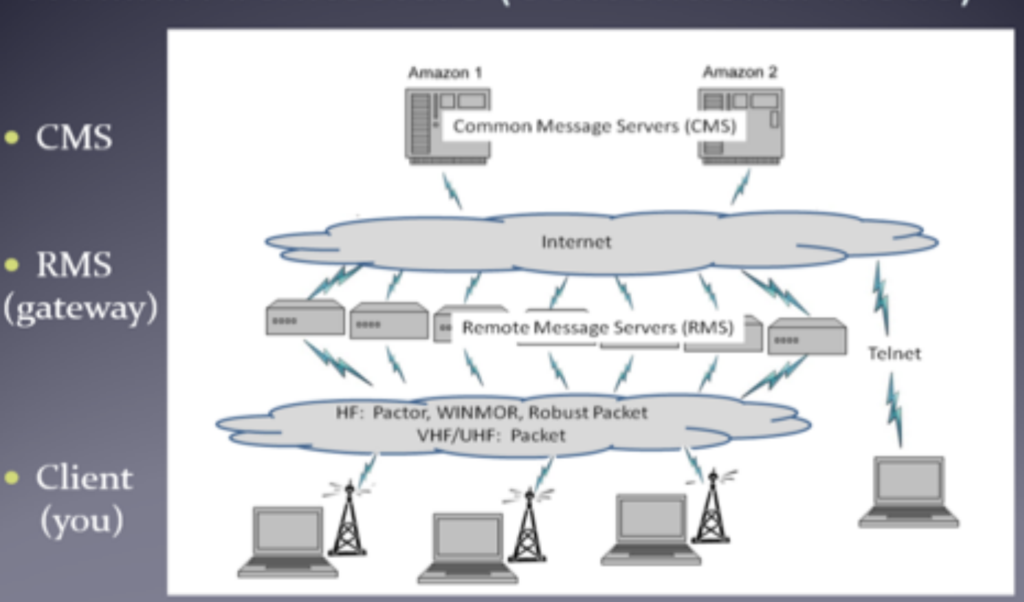NTS Nets – NTS Local – NTSOK Organization – NTSOK Operation – NTSOK Winlink Software – NTSOK Radiogram
NTS over Winlink (NTSOK)
Since the NTS system was designed in the 1950s to be modular and allow for different organizations, modes, and message paths. To keep up with changes in amateur radio technology and trends, in 2021, NTSOK was developed using the Winlink ( https://winlink.org/ ) system. This lets Oklahoma hams pass traffic with systems that are already in place.
Winlink Overview
The Winlink email system uses a hybrid approach to sending and receiving messages that was designed and is managed by hams, for hams. The intriguing part of this system is that the message storage has been separated from the message delivery mode. All of the ‘back-end’ storage is managed on the public internet, far away from a disaster location. The remote servers can connect to the clients in a dozen different ways. We tend to use three of those paths, ethernet, VARA HF, and VARA FM.
The three layers of this system are shown below, are the Common Message Servers (CMS), the Remote Message Servers (RMS), and the Clients (Winlink Express).

Content Message Servers (CMS)
The CMS devices run software that receives, stores, and forwards messages that are received from RMSs. Since 2017, the multiple CMS servers run in different Amazon data centers to ensure that these devices are available 24 x 7 x 365. An independent server is kept operational that could be activated in minutes if the entire Amazon system collapsed. These servers synchronize the data between themselves and each server maintains up-to-date copies of the message database.
Additionally, the CMS operates as a gateway to the public SMTP email system. Any messages originating on Winlink can be directly delivered to any global email address. In times of need, messages can be sent from the field client software via VHF or HF directly to an organization like the Red Cross or FEMA.
Remote Message Servers (RMS)
There are 677 RMS devices that operate on the VARA HF protocol used by NTSOK. These servers are the gateways between HF, VHF or UHF radios and the Internet. Hams use their Winlink Express client software to connect to the RMS, passing the traffic over one of the dozen transmission modes available. The VARA HF mode is currently the most popular for RMS connections and it provides the fastest throughput over HF radios. Jeff Scoville AE5ME operates a VARA HF RMS in Broken Arrow.
To continue operations when local Internet interruptions occur, there are two options that an RMS can use to continue. The first method is to shut down radio operations when the Internet connection is lost. This will keep clients from connecting to a ‘dead-end’ server. The second method is that the server would continue its operation, but it would forward the message to a neighboring server via a radio connection. The RMS operator chooses the method that is used.
Client Software (Winlink Express)
An amateur radio operator must connect to the Winlink system over the airwaves to connect their HF radio to their Windows computer using a soundcard-type interface. The hardware part is complete if a radio is already set up to operate on PSK-31, FT-8, FT-4, or WSPR. Winlink Express directs the radio to make the transmissions.
Hardware Requirements
With the spread of digital technologies like PSK-31, FT-8, FT-4, and WSPR, more and more hams have connected their HF radios to their computer using a sound card interface. In the Oklahoma area, we can consistently pass traffic on VARA HF 40 M or 80 M using any antenna, with about 10 watts of power. Mobile operation using an Icom 705, a small loop antenna, a laptop, and a battery works well to send messages to and from the regional RMSs. VARA FM can be transmitted using standard FM radios.
VARA FM Oklahoma Network
An Oklahoma VHF network is in operation and is currently expanding. The following Winlink VHF VARA FM stations are scheduled to be on air 24 x 7 x 365.
- WB5ANX is a Winlink VHF gateway in Tulsa, OK, on 145.03 MHz, providing coverage to Midtown Tulsa
- AE5ME-13 is a Winlink VHF gateway in Broken Arrow, OK, on 145.03 MHz
- AE5ME-14 is a Winlink VHF gateway in Ft. Gibson/Muskogee, OK (should have good coverage in the Tulsa area with a 25-watt base radio or a 50-watt mobile radio) on 145.03 MHz
- AE5ME-7 is a VARA FM digipeater in Ft. Gibson/Muskogee, OK. (used to digipeat ‘through’ Ft. Gibson if the Internet is down at the tower) on 145.03 MHz
- W5LHG is a Winlink VHF gateway in Blanchard, OK, on 145.03 MHz. This should have good coverage in the Norman, South OKC area. Reports in the Norman area are that 3 watts with a magnetic mount antenna works well from the Norman Airport.
- N0LOZ-10 is the Winlink VHF gateway in Prague, OK, on 145.03 MHz.
Others who are known to be working on gateways are Vian, Guthrie, East Norman, and NE OKC. Many thanks to all who have put up gateways or are working on gateways in the area.